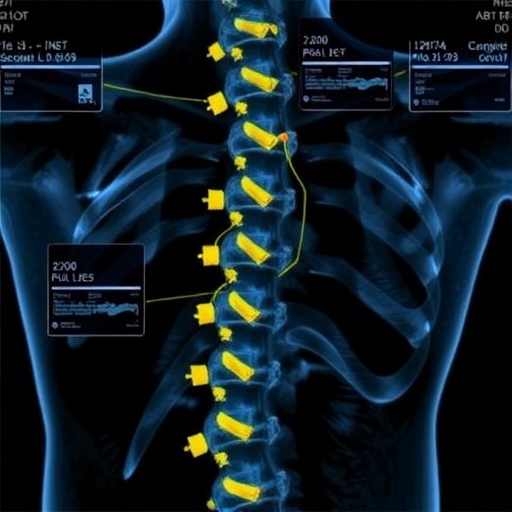In the realm of neuroanatomy and clinical diagnostics, the spinal accessory nerve has often remained a subject of limited investigation, overshadowed by more prominent structures. However, a groundbreaking study spearheaded by researchers Tai, Liu, and Wang has brought this relatively underexplored nerve into the limelight. Their innovative work on high-resolution ultrasound imaging of the spinal accessory nerve not only elucidates its anatomy but also documents associated injuries, providing a normative baseline that could prove invaluable to both clinicians and researchers in the field.
Ultrasound imaging technology has evolved dramatically over recent years, transcending beyond its traditional applications in obstetrics and abdominal assessments. The advent of high-resolution ultrasound offers unparalleled insight into soft tissue structures, making it an ideal tool for investigating peripheral nerves. The research team capitalized on this technology to develop a comprehensive understanding of the spinal accessory nerve. The nerve’s anatomical path, branching patterns, and relationship to adjacent structures were meticulously documented, thereby enhancing the clinical utility of ultrasound techniques in diagnosing nerve-related disorders.
In their study, the researchers conducted a prospective normative study combined with a retrospective analysis, a dual approach that lends robustness to their findings. The prospective aspect involved the examination of healthy individuals, unraveling the normative anatomical characteristics of the spinal accessory nerve. This foundational data serves as crucial reference points for understanding potential deviations seen in pathological conditions. Meanwhile, the retrospective facet examined previously documented cases of nerve injuries, allowing the researchers to correlate their ultrasound findings with clinical presentations.
A particularly notable aspect of the study is the emphasis on the practical applications of high-resolution ultrasound. The research team illustrated how this imaging technique could be integrated into routine clinical assessments, providing real-time information that could guide surgical planning and intervention strategies. Traditional imaging modalities, such as MRI, often lack the real-time feedback necessary during surgical procedures. In contrast, ultrasound can facilitate dynamic assessments, prompting timely and informed decisions by healthcare providers.
Moreover, the study highlighted the potential for high-resolution ultrasound to enhance the visibility of nerve injuries, which are often challenging to visualize with conventional imaging techniques. By delineating the anatomical intricacies of the spinal accessory nerve, the researchers unveiled how collagen scarring and neuromas could compromise the nerve’s integrity. Such insights are critical, as they underscore the importance of accurate diagnosis when managing nerve injuries post-operatively, where misjudgment could lead to further complications.
Throughout their research, the authors engaged various imaging techniques, refining their protocols to optimize ultrasound visualization. Their keen attention to detail ensured that both superficial and deeper anatomical structures around the spinal accessory nerve were captured, providing a more holistic view of the area. Such precision is paramount for healthcare professionals when attempting to avoid inadvertent nerve damage during surgical procedures.
As they disseminate their findings, Tai and colleagues have ignited conversations within the medical community regarding the utility of high-resolution ultrasound. They advocate for increased training of clinicians in ultrasound techniques specifically tailored for nerve imaging. The capacity to visualize nerves without exposing patients to ionizing radiation presents a compelling argument for the wider adoption of this technology in clinical setups.
The implications of their research stretch beyond the immediate clinical arena. The normative data derived from their study can inform academic research, fostering a deeper understanding of nerve pathologies and facilitating the development of novel therapeutic strategies. Additionally, this work paves the way for future studies aimed at integrating ultrasound imaging with other advanced modalities, such as electromyography, to provide a multi-faceted approach to diagnosing and managing nerve injuries.
Building on their insights, the authors also pose an interesting challenge to the existing paradigms surrounding nerve injury treatment. Current treatment protocols largely depend on subjective assessments and limited imaging capabilities. The advent of high-resolution ultrasound necessitates a paradigm shift towards more objective, evidence-based approaches. This foresight could redefine how clinicians approach nerve injuries, steering them towards more proactive and personalized intervention strategies.
In conclusion, this pioneering study by Tai, Liu, and Wang marks a significant advancement in the field of neuroimaging, particularly concerning the spinal accessory nerve. Their work demonstrates the capabilities of high-resolution ultrasound in revealing intricate neural anatomy and detecting injuries, making a strong case for its integration into routine clinical practice. As the discourse surrounding nerve injuries evolves, the contributions from this research will undeniably shape the future landscape of diagnostic and therapeutic strategies.
The journey of redefining the assessment of the spinal accessory nerve through high-resolution imaging illustrates the intersection of technology and medicine. Such pioneering research is vital as it opens new avenues for exploration within both clinical and academic domains. The promise of high-resolution ultrasound is not merely in its diagnostic capabilities but in its potential to revolutionize patient care, making it a focal point for ongoing discussions in medical innovation.
In the ever-evolving landscape of medical imaging, the work conducted by Tai and colleagues serves as a beacon of hope for individuals suffering from nerve-related injuries. As these researchers continue to shed light on the importance of ultrasound technology, it is clear that the future holds great promise for the integration of advanced imaging techniques into everyday clinical practice, ultimately leading to improved patient outcomes and more effective nerve injury management.
Subject of Research: High-resolution ultrasound imaging of the spinal accessory nerve and associated injuries
Article Title: High-resolution ultrasound imaging of the spinal accessory nerve and associated injuries based on a prospective normative study and retrospective analysis.
Article References:
Tai, Z., Liu, L., Wang, T. et al. High-resolution ultrasound imaging of the spinal accessory nerve and associated injuries based on a prospective normative study and retrospective analysis.
Sci Rep 15, 40062 (2025). https://doi.org/10.1038/s41598-025-26644-3
Image Credits: AI Generated
DOI: https://doi.org/10.1038/s41598-025-26644-3
Keywords: Ultrasound imaging, spinal accessory nerve, nerve injuries, neuroanatomy, clinical diagnostics.
Tags: clinical applications of ultrasoundhigh-resolution ultrasound imaginginnovative neurodiagnostic methodsnerve injury diagnosticsneuroanatomy research advancementsnormative baseline for nerve injuriesperipheral nerve assessment techniquesprospective and retrospective study designsoft tissue imaging technologyspinal accessory nerve anatomyspinal nerve injury documentationultrasound in clinical practice





